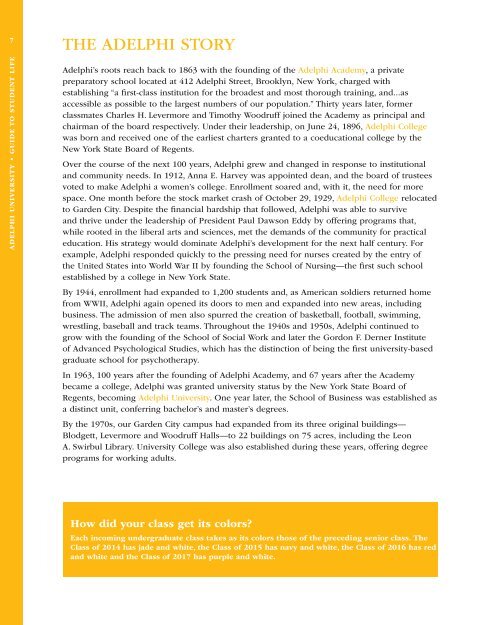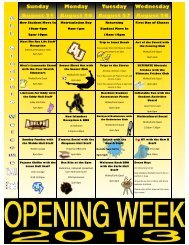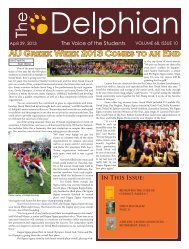Guide to Student Life - Campus Life - Adelphi University
Guide to Student Life - Campus Life - Adelphi University
Guide to Student Life - Campus Life - Adelphi University
You also want an ePaper? Increase the reach of your titles
YUMPU automatically turns print PDFs into web optimized ePapers that Google loves.
7<br />
THE ADELPHI STORY<br />
ADELPHI UNIVERSITY • GUIDE TO STUDENT LIFE<br />
<strong>Adelphi</strong>’s roots reach back <strong>to</strong> 1863 with the founding of the <strong>Adelphi</strong> Academy, a private<br />
prepara<strong>to</strong>ry school located at 412 <strong>Adelphi</strong> Street, Brooklyn, New York, charged with<br />
establishing “a first-class institution for the broadest and most thorough training, and...as<br />
accessible as possible <strong>to</strong> the largest numbers of our population.” Thirty years later, former<br />
classmates Charles H. Levermore and Timothy Woodruff joined the Academy as principal and<br />
chairman of the board respectively. Under their leadership, on June 24, 1896, <strong>Adelphi</strong> College<br />
was born and received one of the earliest charters granted <strong>to</strong> a coeducational college by the<br />
New York State Board of Regents.<br />
Over the course of the next 100 years, <strong>Adelphi</strong> grew and changed in response <strong>to</strong> institutional<br />
and community needs. In 1912, Anna E. Harvey was appointed dean, and the board of trustees<br />
voted <strong>to</strong> make <strong>Adelphi</strong> a women’s college. Enrollment soared and, with it, the need for more<br />
space. One month before the s<strong>to</strong>ck market crash of Oc<strong>to</strong>ber 29, 1929, <strong>Adelphi</strong> College relocated<br />
<strong>to</strong> Garden City. Despite the financial hardship that followed, <strong>Adelphi</strong> was able <strong>to</strong> survive<br />
and thrive under the leadership of President Paul Dawson Eddy by offering programs that,<br />
while rooted in the liberal arts and sciences, met the demands of the community for practical<br />
education. His strategy would dominate <strong>Adelphi</strong>’s development for the next half century. For<br />
example, <strong>Adelphi</strong> responded quickly <strong>to</strong> the pressing need for nurses created by the entry of<br />
the United States in<strong>to</strong> World War II by founding the School of Nursing—the first such school<br />
established by a college in New York State.<br />
By 1944, enrollment had expanded <strong>to</strong> 1,200 students and, as American soldiers returned home<br />
from WWII, <strong>Adelphi</strong> again opened its doors <strong>to</strong> men and expanded in<strong>to</strong> new areas, including<br />
business. The admission of men also spurred the creation of basketball, football, swimming,<br />
wrestling, baseball and track teams. Throughout the 1940s and 1950s, <strong>Adelphi</strong> continued <strong>to</strong><br />
grow with the founding of the School of Social Work and later the Gordon F. Derner Institute<br />
of Advanced Psychological Studies, which has the distinction of being the first university-based<br />
graduate school for psychotherapy.<br />
In 1963, 100 years after the founding of <strong>Adelphi</strong> Academy, and 67 years after the Academy<br />
became a college, <strong>Adelphi</strong> was granted university status by the New York State Board of<br />
Regents, becoming <strong>Adelphi</strong> <strong>University</strong>. One year later, the School of Business was established as<br />
a distinct unit, conferring bachelor’s and master’s degrees.<br />
By the 1970s, our Garden City campus had expanded from its three original buildings—<br />
Blodgett, Levermore and Woodruff Halls—<strong>to</strong> 22 buildings on 75 acres, including the Leon<br />
A. Swirbul Library. <strong>University</strong> College was also established during these years, offering degree<br />
programs for working adults.<br />
How did your class get its colors<br />
Each incoming undergraduate class takes as its colors those of the preceding senior class. The<br />
Class of 2014 has jade and white, the Class of 2015 has navy and white, the Class of 2016 has red<br />
and white and the Class of 2017 has purple and white.

















